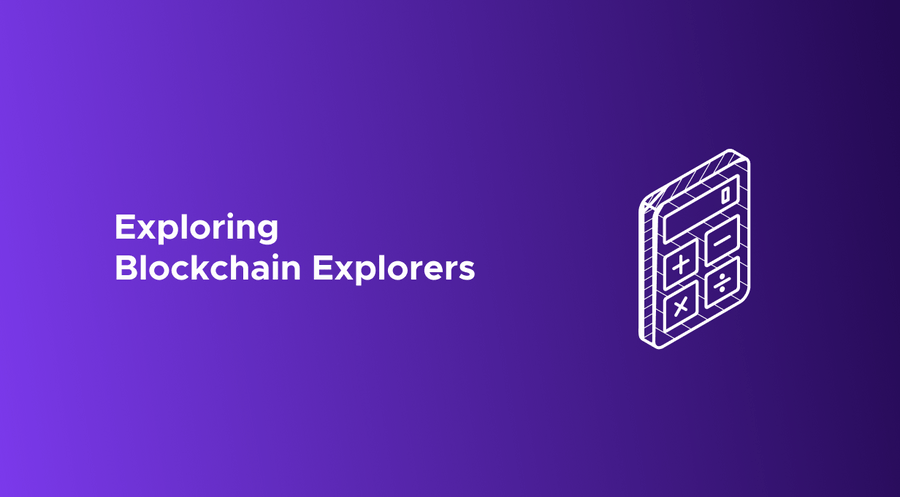How to use a blockchain explorer

What is a blockchain explorer?
So you’ve been in the world of crypto for a little while now, and you’re excited by all the opportunities it presents. You know of this digital ledger each blockchain consists of, and maybe you even understand how this digital ledger works to facilitate decentralized, accurate, speedy transactions - but how do you actually view these transactions? If everything’s recorded on the blockchain, where can you access all this data? Enter: blockchain explorers.
A blockchain explorer (or block explorer) allows users to access details related to transactions on specific blockchains and wallet addresses; including amounts transacted, sources and destinations of funds, and the status of the transactions themselves. It basically provides a window into the specific blockchain world you’re looking into, so you can observe and track what’s happening within it.
How do blockchain explorers work?
A blockchain explorer works by drawing data from the blockchain via a node and translating it into a searchable format. Usually, each blockchain explorer will be focused on a particular blockchain (e.g. Etherscan for Ethereum, Blockstream for Bitcoin, SnowTrace for Avalanche, and more). An explorer works with the node on the blockchain to extract all the relevant data from the latest blocks and transactions and sends them to their web service. After this point, the data is compiled and formatted into a more easily searchable format. This may take the form of searchable tables, charts, volume analysis and more.
How can I use a blockchain explorer?
Let’s use Etherscan to explain the basic concepts to learn when using a block explorer. For context, most block explorers share a lot of the same formatting, so you should be able to apply these learnings more widely.
Etherscan is a blockchain explorer for the Ethereum network and allows you to search through transactions, blocks, wallet addresses, smart contracts and more. To use Etherscan, you’ll need either a wallet address, transaction ID or smart contract address to search. Depending on what identifier you use to search will determine what information you see as a result, but it will include things like associated transactions, timestamps and value amounts.
Let’s say you’re sending ETH from your Coinbase account to your MetaMask wallet. If this is done on the Ethereum mainnet, you’ll be able to use Etherscan to track this transaction.
- Wallet addresses: You can track this transaction on Etherscan using either your Coinbase wallet address or your MetaMask wallet address. If you use your Coinbase wallet address to search in Etherscan, you should see an outgoing transaction ‘from’ your Coinbase wallet address and ‘to’ your MetaMask wallet address (see below for an example).

- You could also find this same information by searching the specific transaction hash generated upon confirming the transfer in Coinbase. You will be provided with a tx hash that you can copy and paste into Etherscan to track the transfer’s progress.
Blockchain explorers and taxes
As previously stated, a blockchain explorer allows users to access details related to transactions on specific blockchains and/or wallet addresses. This is very important when it comes to staying tax compliant. In order to ascertain where a particular transaction’s value originated, if it was a buy, if it was a sell, if it was a transfer; you’ll need to become very familiar with blockchain explorers.
While you can use these to help you track everything from cost bases to transaction fee amounts, you can imagine how time-consuming this process would become after anything more than 10 transactions… That’s where Crypto Tax Calculator comes in! Where possible, our software pulls in the same data as blockchain explorers to facilitate the tracking for you. All possible transactions will be pulled into the app and categorized accordingly, and you should only need to use a block explorer for any uncategorized transactions. When and if you do need to use a block explorer throughout your Crypto Tax Calculator experience, you can use the above steps to help guide you!
The information provided on this website is general in nature and is not tax, accounting or legal advice. It has been prepared without taking into account your objectives, financial situation or needs. Before acting on this information, you should consider the appropriateness of the information having regard to your own objectives, financial situation and needs and seek professional advice. Cryptotaxcalculator disclaims all and any guarantees, undertakings and warranties, expressed or implied, and is not liable for any loss or damage whatsoever (including human or computer error, negligent or otherwise, or incidental or Consequential Loss or damage) arising out of, or in connection with, any use or reliance on the information or advice in this website. The user must accept sole responsibility associated with the use of the material on this site, irrespective of the purpose for which such use or results are applied. The information in this website is no substitute for specialist advice.